MIST
Magnetosphere, Ionosphere and Solar-Terrestrial
Nuggets of MIST science, summarising recent papers from the UK MIST community in a bitesize format.
If you would like to submit a nugget, please fill in the following form: https://forms.gle/Pn3mL73kHLn4VEZ66 and we will arrange a slot for you in the schedule. Nuggets should be 100–300 words long and include a figure/animation. Please get in touch!
If you have any issues with the form, please contact This email address is being protected from spambots. You need JavaScript enabled to view it..
Classifying Magnetic Reconnection Regions Using k-Means Clustering: Applications to Energy Partition
By Cara Waters (Imperial College London)
Magnetic reconnection is a universal process which facilitates the repartition of magnetic energy to particle energies. It is important to understand the structure of reconnection regions and how they convert and partition energy. As visual identification of such structures can be subjective and time consuming, we take an unsupervised machine learning approach involving k-means clustering.
Carrying out this clustering on a 2.5-D particle-in-cell simulation of symmetric reconnection comparable to that in Earth’s magnetotail, we identify that the optimal number of clusters is six. We input only field and plasma variables to the clustering, giving a result which is independent of position. We identify two inflow regions, two outflow regions, and two pairs of separatrices. By looking at the distributions of the energy flux densities in these regions, we confirm that outgoing particle energy flux densities from reconnection decrease as guide field increases. The ion enthalpy flux density is the most dominant form of energy flux density in the outflows, agreeing with previous studies, and Poynting flux density may be dominant at some points in the outflows and is only half that of the Poynting flux density in the separatrices. This demonstrates an approach which may be applied to large volumes of data to determine statistically different regions within phenomena in simulations and could be extended to in situ observations, applicable to future multi-point missions.
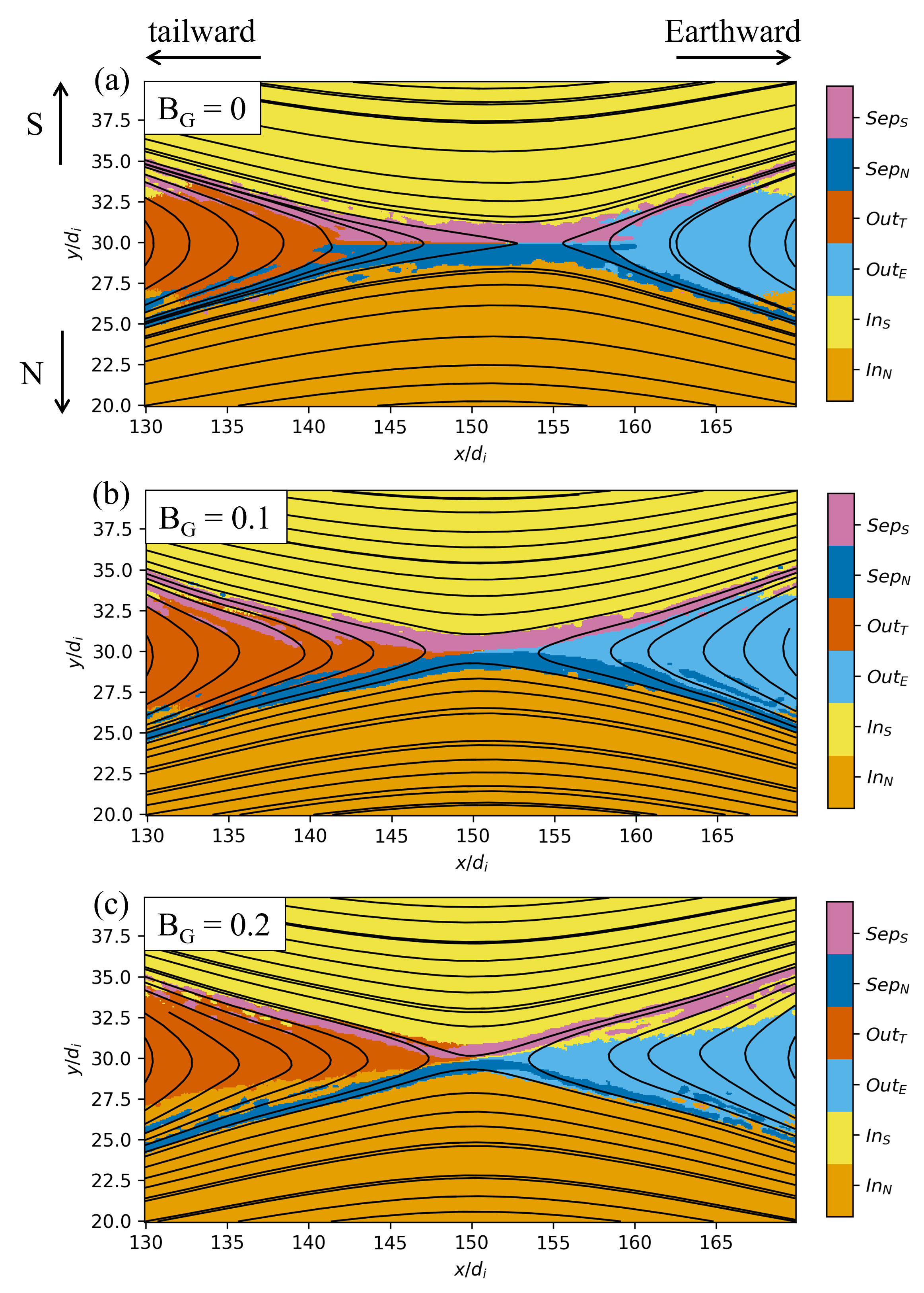
Results of carrying out k-means clustering with six clusters on comparable simulation runs with (a) BG = 0, (b) BG = 0.1, and (c) BG = 0.2. Magnetic field lines are shown in black, with the colour showing the regions identified by the k-means clustering. These regions are labelled in relation to the equivalent directions in GSM coordinates in the case of magnetotail reconnection. Each simulation run has k-means carried out independently with variables scaled in the same manner and subsequent clusters re-numbered for comparison between each case.
See publication for details:
Cara L. Waters, Jonathan P. Eastwood, Naïs Fargette, David L. Newman, Martin V. Goldman. Classifying Magnetic Reconnection Regions Using k-Means Clustering: Applications to Energy Partition, JGR: Space Physics, 2024, 129, 10. https://doi.org/10.1029/2024JA033010
Release of the 14th Generation of the IGRF
By Ciaran Beggan (British Geological Survey)
The standard reference model for the Earth’s main magnetic field is known as the International Geomagnetic Reference Field (IGRF). Its primary purpose is to aid scientific research as well as general navigation.
The Earth’s main magnetic field is not static and it changes slowly over time as a result of the chaotic and unpredictable flow of liquid nickel-iron in the outer core. To account for the change (known as secular variation), the geomagnetic community produces an updated version of the IGRF every five years. The latest IGRF is the 14th update and was released in November 2024 to ensure the continuation from the 13th generation whose validity ended in January 2025.
The model consists of a series of snapshot Gauss coefficients every five years from 1900 to 2030. Gauss coefficients can be thought of as the weights assigned to spherical harmonic functions, the summation of which allows a compact and efficient method of determining the magnetic field anywhere on the globe, above or below the surface. The coefficients are defined to degree and order 13 in the latest generation, which gives an approximate spatial resolution of 3000km at the surface.
Analysis shows that the Earth’s magnetic field continues to drift westwards across most the globe and weaken. The South Atlantic Anomaly which has deepened by around 150 nanoTesla over five years and moved westward at around 20km/year. A second low point offshore of South Africa is forming. The magnetic dip pole in the northern hemisphere continues to move rapidly away from Canada toward Siberia at a rate of 35km/year. In contrast, the southern hemisphere pole velocity has remained below 10km/yr since the 1960s. Interestingly, in early to mid-2026, both poles should briefly have the same longitude (136°E).
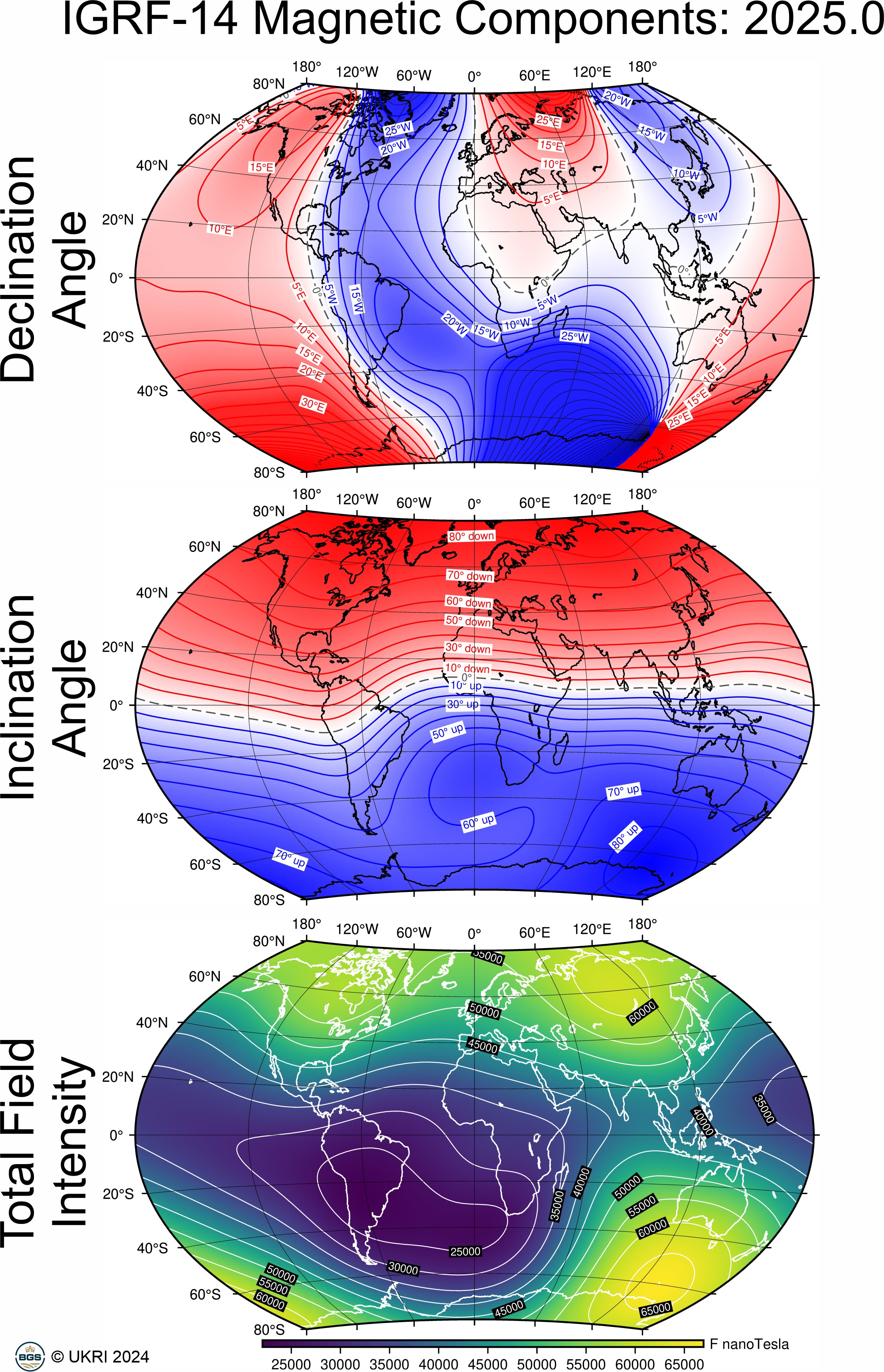
Maps of the three components of the magnetic field at 2025. The panels illustrate the Declination angle (i.e. angle between true and magnetic North), the Inclination (or magnetic dip) and Total Field Intensity from IGRF-14.
Resolving velocity distribution function parameters from observations with significant Poisson statistical uncertainty
By Georgios Nicolaou (Mullard Space Science Laboratory, UCL)
The interpretation of plasma in-situ measurements often involves the application of standard analysis methods to the observations. Some of these methods adopt simplifications that lead to erroneous results. A recently published study led by Georgios Nicolaou uses simulations of plasma measurements and evaluates the statistical errors of plasma parameters determined by applying three different analysis methods to the data. The study shows that two classic fitting techniques that use chi-squared minimization result in significant systematic misestimations of the plasma parameters when applied to samples with credible statistical uncertainty. On the other hand, the application of the Poisson maximum likelihood method to the same data samples always returns the plasma parameters with negligible systematic errors. The authors quantify the expected errors of the examined methods as functions of the statistical significance of the observations. A follow-up study led by Georgios shows that a classic chi-squared minimization method creates artificial correlations to the determined plasma densities and temperatures, which may be misinterpreted as an actual characteristic behaviour of the examined plasma. However, this is not an issue when the Poisson maximum likelihood method is used to analyse the same observations.
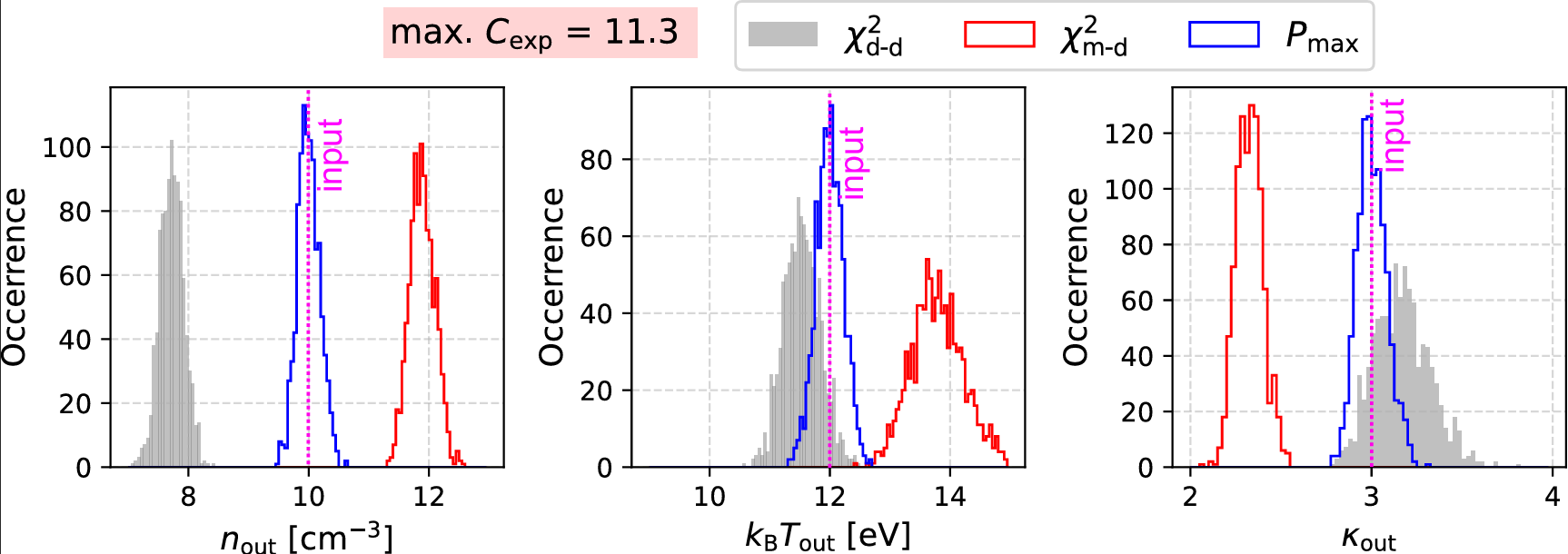
Histograms of plasma bulk parameters determined by applying the three different fit methods to the same measurement samples.
(Left) Plasma density, (middle) temperature, and (right) kappa index, determined by using
Method A: chi-squared minimization with data-driven uncertainty (grey),
Method B: chi-squared minimization with model-driven uncertainty (red), and
Method C: maximum-likelihood method (blue).
The actual plasma parameters (simulation input) are indicated by the vertical magenta line in each panel.
Publications:
Nicolaou, G., Livadiotis, G., Sarlis, N., Ioannou, C. Resolving velocity distribution function parameters from observations with significant Poisson statistical uncertainty, RAS Techniques and Instruments, 2024 3, 874, https://doi.org/10.1093/rasti/rzae059
Nicolaou, G., Livadiotis, G., Ioannou, C. Artificial Polytropic Behavior of Plasmas Determined from the Application of Chi-squared Minimization Analysis to Data with Significant Statistical Uncertainty, The Astrophysical Journal, 2024, 977, 168, 10.3847/1538-4357/ad8f35
Characterising meso-scale ionospheric flow structures
By Gareth Chisham (British Antarctic Survey)
Measuring and understanding ionospheric plasma flow vorticity aids the study of ionospheric plasma transport processes, such as convection and turbulence, which form an important component of magnetosphere to atmosphere space weather models. This plasma flow is dominated by the large-scale convection driven by solar wind-magnetosphere-ionosphere coupling.
This study (https://doi.org/10.1029/2024JA032887) exploits a recently-developed technique that allows the removal of this large-scale component from probability density functions (PDFs) of ionospheric vorticity measured by the Super Dual Auroral Radar Network (SuperDARN). Following this removal, the residual PDFs are symmetric double-sided functions that describe the meso-scale vorticity component that derives from processes below the large scale, such as turbulence. The character of this meso-scale component varies with location in the polar ionosphere, as shown in the figure. The ability to characterise the meso-scale flows in different regions helps to improve our understanding of the meso-scale processes occurring there. Models of ionospheric plasma flow are an important component in larger-scale system models. However, at the present time, these plasma flow models only consider the large-scale convection flow. Understanding, and being able to model, meso-scale ionospheric vorticity will help improve the accuracy of these models.
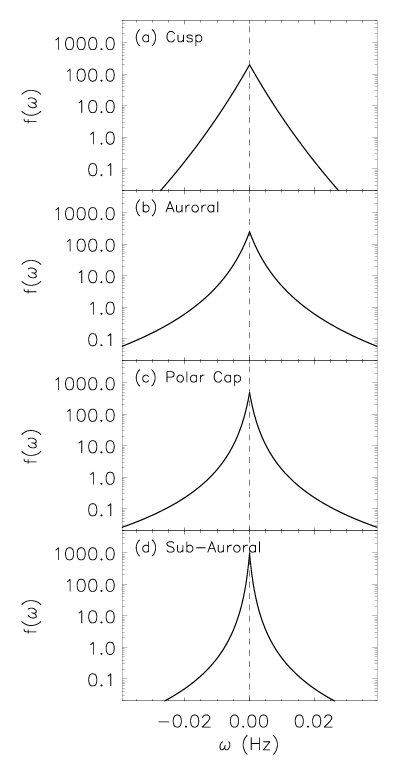
This figure presents schematic representations of the typical probability density functions (PDFs – f(ω))
of meso-scale ionospheric vorticity (ω) that are observed in different regions of the polar ionosphere:
(a) Dayside cusp; (b) Auroral region; (c) Polar cap; (d) Sub-auroral region.
Publication:
Chisham, G., and Freeman, M.P., The spatial variation of large- and meso-scale plasma flow vorticity statistics in the high-latitude ionosphere and implications for ionospheric plasma flow models. J. Geophys. Res., 129, e2024JA032887, 2024.
https://doi.org/10.1029/2024JA032887
Observation of a Fully-formed Forward–Reverse Shock Pair due to the Interaction between Two Coronal Mass Ejections at 0.5 au
By Domenico Trotta (Imperial College London)
The Sun is an active star, responsible for creating a highly dynamic and complex environment, namely the heliosphere. Solar eruptive phenomena are key consequences of such activity, which recently reached the peak of its 11-years cycle, and their study is of paramount importance to understand many unsolved mysteries of how energy is converted in space and astrophysical plasmas [1], as well as to advance our understanding of space weather, for which they are major drivers [2]. Further, novel spacecraft missions, such as Solar Orbiter [3], are opening a novel observational window into such phenomena with revolutionary measurements in the poorly explored inner heliospheric regions close to the Sun.
Solar eruptive phenomena can drive shock waves in the heliosphere (i.e., interplanetary IP shocks), which crucially can be detected in-situ, thus representing the missing link to remote observations of astrophysical systems. Sometimes IP shocks are observed in forward-reverse pairs, propagating away and towards the Sun in the local plasma frame. Forward-reverse shock pairs typically bound compressed plasma regions at solar wind Stream Interaction Regions (SIRs) between slow and fast wind originating from coronal holes [4]. Early observational evidence shows that fully formed forward-reverse shock pairs are very rare in the inner heliosphere, and more commonly observed beyond 1 AU [5]. Conversely, Coronal Mass Ejections (CMEs), the largest eruptive events from the Sun, are routinely found driving forward shocks able to accelerate particles to high energies [6]. Further, interaction between multiple CMEs has been shown as a promising pathway for fast energy conversion in the heliosphere, with a complex range of phenomena being observed in such interaction.
In our study, exploiting the in-situ Solar Orbiter instrument payload, we identified a fully formed forward-reverse shock pair at the unusually short heliocentric distance of 0.5 AU. The observation is shown in Figure 1. We found that such shock pair was not originating from a solar wind SIR, but rather from the interaction between a fast CME interacting with a preceding, slow CME, thereby creating a compression region driving the shock pair due its expansion. This enabled us to study IP shocks in highly unusual parameter regimes (for example the forward shock propagating in CME material). Further, in the interaction region between the two CMEs, a large range of interesting phenomena of energy conversion, such as enhanced rate of magnetic reconnection, has been identified.
We then used remote observations from STEREO-A to identify the two CMEs as they were ejected from the Sun, revealing that the first, slow CME was an extremely faint event. Finally, we used well the radially aligned Wind spacecraft to investigate the fate of such interesting structure, and found that it dissipated at 1 AU, where only a weak forward shock is observed, in stark contrast with SIR-driven shock pairs expected to become stronger with heliocentric distances. Thus, we highlighted how without Solar Orbiter at inner heliocentric distance, such structure would not have been possible to observe and investigate, once again underlining how exploiting multiple heliospheric vantage points is invaluable to advance our understanding of both the Sun-Earth system and remote astrophysical environments.
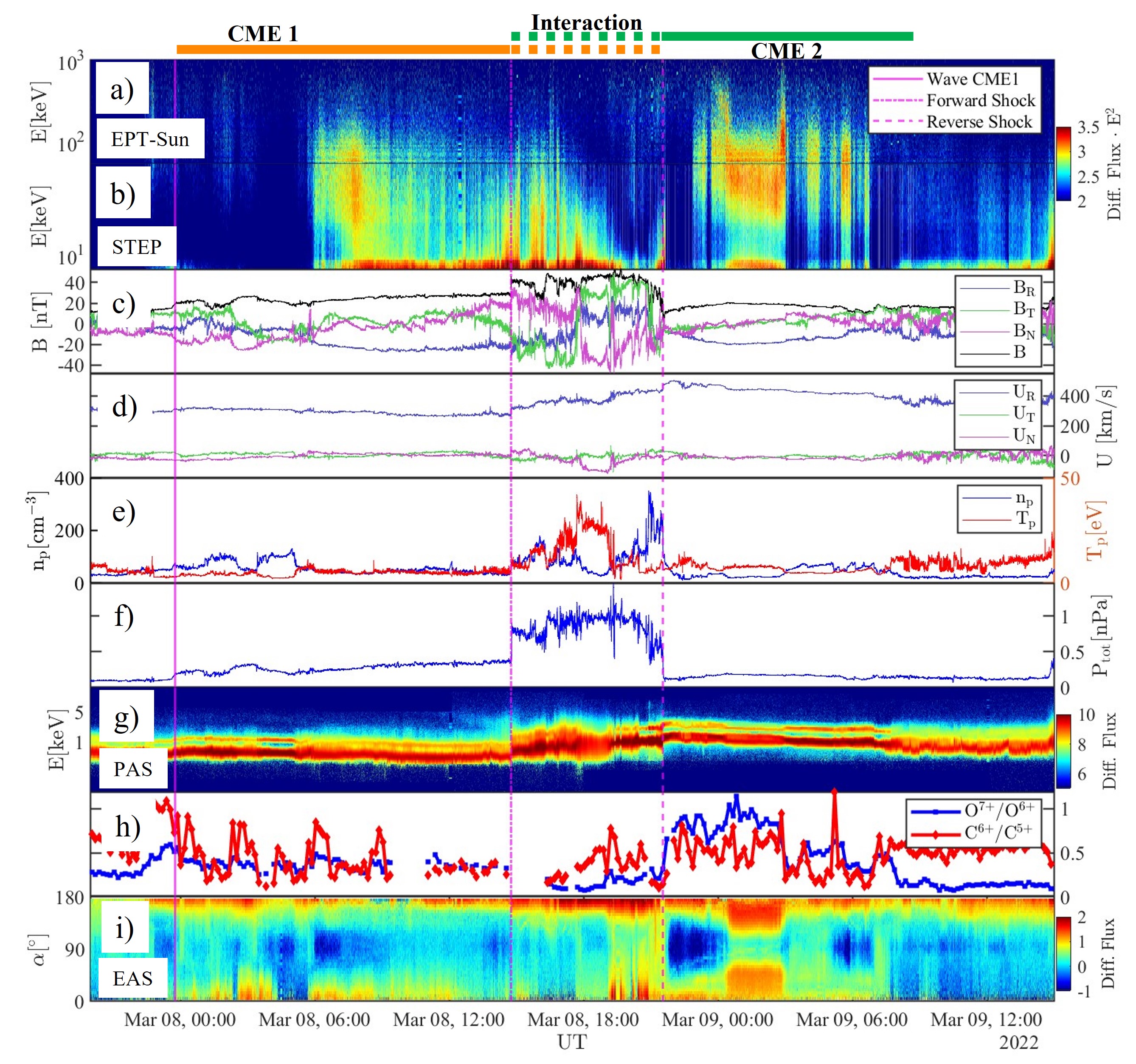
Solar Orbiter direct observation of the forward-reverse shock pair and the interacting CMEs
(full details in the publication).
References:
[1] Rice et al., JGR: Space Physics, 108, 1369 (2003)
[2] Temmer, Liv. Rev. in Sol. Phys., 18, 4 (2021)
[3] Muller et al., A&A, 642, A1 (2020)
[4] Belcher, ApJ, 168, 509 (1971)
[5] Jian et al., Sol. Physics, 239, 337 (2006)
[6] Chen, Liv. Rev. in Sol. Phys., 8, 1 (2011)
See publication for details:
Domenico Trotta et al 2024 ApJL 971 L35
DOI 10.3847/2041-8213/ad68fa